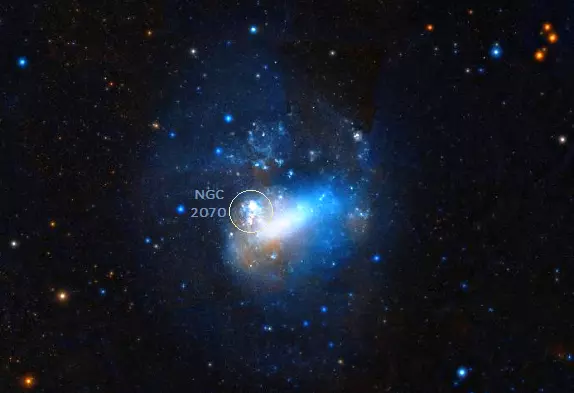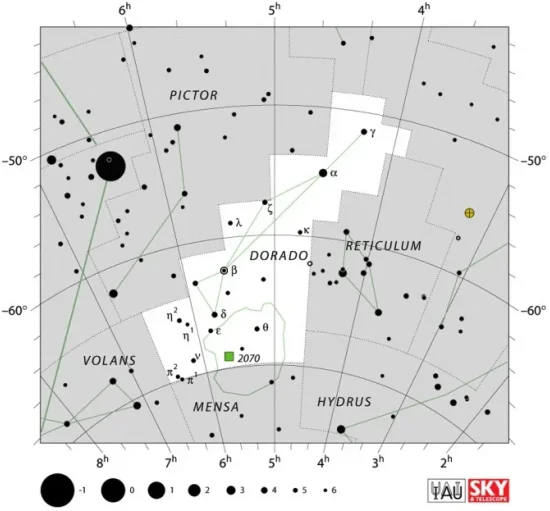BAT99-98 is a Wolf-Rayet star located in the Tarantula Nebula in the Large Magellanic Cloud. With a mass 226 times that of the Sun and luminosity 5 million times solar, it is one of the most massive and luminous stars discovered to date. It lies approximately 165,000 light years away and has an apparent magnitude of 13.38.
Star type
BAT99-98 is a Wolf-Rayet star, a young, exceptionally hot and luminous star that has evolved quickly due to its high mass. It has the stellar classification WN6, indicating dominant lines of ionized nitrogen. Like all Wolf-Rayet stars, BAT99-98 is losing mass at a high rate and will most likely go out as a supernova in the relatively near future. It has already lost more than 20 solar masses of its initial mass (250 M☉).
With a mass 226 times that of the Sun, BAT99-98 is one of the most massive stars known. It shines with 5,000,000 solar luminosities with an effective temperature of 45,000 K. This also makes it one of the most luminous stars known. However, most of its energy output is in the invisible ultraviolet part of the spectrum. Visually, it is only 141,000 times more luminous than the Sun.
Even though it is exceptionally massive, BAT99-98 is not proportionately large. It has a radius 37.5 times that of the Sun. This makes it the same size as Polaris, a white supergiant with a modest mass of 5.4 M☉. Even though both stars are behemoths, they are nowhere near the list of the largest known stars.
BAT99-98 is larger than fellow Wolf-Rayet stars Regor (6 R☉) and WR 104 (3.29 R☉) but does not even come close to supergiants like Rigel (78.9 R☉), Betelgeuse (764 – 1021 R☉), Antares (680 R☉), Mu Cephei (972 R☉), and the record-holders UY Scuti (1,708 R☉) and Stephenson 2-18 (2,150 R☉).
Most massive star
With a mass of 226 solar masses BAT99-98 is one of the most massive stars discovered to date, if not the record holder itself. It resides in the Tarantula Nebula, a vast stellar nursery in the Large Magellanic Cloud which is home to some of the most massive and luminous stars known. BAT99-98 is rivalled by the nearby fellow Wolf-Rayet star R136a1 (184 – 260 M☉) in the R136 cluster near the centre of the Tarantula Nebula.
Supernova
Like all massive stars, BAT99-98 is a supernova or hypernova candidate. However, the star’s exact fate is difficult to determine because it depends on the amount of mass loss. BAT99-98 may produce a gamma-ray burst and leave behind a neutron star or black hole. There may even not be a visible supernova.
Exceptionally massive stars are generally expected to meet their ends as type Ib or Ic supernovae. These supernova events are produced by the core collapse of stars that have ejected their outer envelopes of hydrogen and helium due to strong stellar winds. Progenitors of type Ib supernovae have lost most of their outer helium layer, while type Ic progenitors have expelled both their helium and hydrogen layers.
Facts
BAT99-98 was discovered by the astrophysicist Jorge Melnick of the European Southern Observatory during a survey of the Tarantula Nebula in 1978. Melnick discovered six new Wolf-Rayet stars brighter than magnitude 14, located within 2 arcminutes of the core of the nebula. He found that these six stars were associated with the nebula’s central cluster (R136). He listed BAT99-98 as star J of the spectral type WN-5, with an apparent magnitude of 13.5.
In 1985, Melnick conducted another spectrographic study of the central stars in the Tarantula Nebula and determined improved spectral types for them. BAT99-98 was listed as star 49 (Melnick 49) and given the spectral class WN7.
Name
BAT99-98 does not have a proper name. It is commonly referred to by its BAT99 number or its designation in the Brey catalogue of Wolf-Rayet stars in the Large Magellanic Cloud (Brey 79). The BAT99 number is taken from The Fourth Catalogue of Population I Wolf Rayet Stars in the Large Magellanic Cloud, published in 1999. The BAT designation comes from the initials of J. Breysacher, M. Azzopardi and G. Testor, who compiled the catalogue.
The star is also sometimes referred to as Melnick 49. Other designations, including LMC AB 12 and NGC 2070 Mel J, are used less frequently.
Location
BAT99-98 lies in the vicinity of the R136 cluster in the Tarantula Nebula, located in the southern constellation Dorado. It has similar mass and luminosity to the stars in R136. With an apparent magnitude of 13.38, the star is invisible to the unaided eye.
Also catalogued as NGC 2070 and 30 Doradus, the Tarantula Nebula is the most active star-forming region in the Local Group of galaxies, as well as one of the largest. Many of its stars are among the largest, most massive and most luminous stars known. The nebula has an apparent magnitude of 8 and is easily observed in small telescopes.

Tarantula Nebula in the Large Magellanic Cloud (LMC), image: Wikisky
Constellation
BAT99-98 is located in the southern constellation Dorado. Representing the dolphinfish, Dorado is one of the smallest constellations in the sky – the 72nd in size out of 88 – with an area of only 179 square degrees. Largely invisible to northern observers, the constellation was created by the Dutch-Flemish astronomer Petrus Plancius in the 16th century, when Dutch explorers started mapping the southern skies. Dorado is one of the several faint constellations in the region between the bright Canopus in Carina and Achernar at the southern end of Eridanus.
Dorado does not have any stars brighter than magnitude 3.00. The constellation’s luminary, the white giant Alpha Doradus, shines at magnitude 3.27.

Dorado constellation map by IAU and Sky&Telescope magazine
Dorado is best known for hosting the larger part of the Large Magellanic Cloud (the rest being in the neighbouring constellation Mensa), a satellite galaxy of the Milky Way, expected to collide with our galaxy in about 2.4 billion years. Located only 163,000 light years away, the Large Magellanic Cloud hosts a number of well-known deep sky objects. These include the emission nebulae N 180B, N44, the Ghost Head Nebula (NGC 2080), the Seagull Nebula (NGC 2032), and the Tarantula Nebula (NGC 2070, 30 Doradus).
The Tarantula Nebula hosts many exceptionally large, massive and luminous stars. These include the red supergiants WOH G64 (1,540 – 1,730 R☉) and WOH S140 (1,477 –1,974 R☉), the blue supergiant Melnick 42 (189 M☉, 3,600,000 L☉), and the Wolf-Rayet stars R136a1 (215 M☉, 6,166,000 L☉), R136a2 (187 M☉, 5,623,000 L☉), R136c (142 M☉, 3,800,000 L☉), and VFTS 682 (137.8 M☉, 3,200,000 L☉).
Other notable stars in Dorado include the variable red giant R Doradus, the star with the largest apparent size other than the Sun, the luminous blue variable S Doradus, a prototype for its own class of variables, and the pulsating variable star Gamma Doradus, another variable class prototype.
The best time of year to observe the stars and deep sky objects in Dorado is during the month of January, when the constellation reaches its highest point above the horizon. The entire constellation is visible from locations between the latitudes 20° N and 90° S.
The 10 brightest stars in Dorado are Alpha Doradus (mag. 3.27), Beta Doradus (mag. 3.46 – 4-08), Gamma Doradus (mag. 4.25), Delta Doradus (mag. 4.34), HD 40409 (mag. 4.65), Zeta Doradus (mag. 4.82), Theta Doradus (mag. 4.82), Eta2 Doradus (mag. 5.01), Nu Doradus (mag. 5.06), and Epsilon Doradus (mag. 5.11).
BAT99-98
| Spectral class | WN6 |
| B-V colour index | -0.10 |
| Apparent magnitude | 13.38 |
| Absolute magnitude | -8.11 |
| Absolute magnitude (bolometric) | -12.0 |
| Distance | 165,000 light years (50,600 parsecs) |
| Parallax | 0.0288 ± 0.0159 mas |
| Proper motion | RA: 1.680 ± 0.021 mas/yr |
| Dec.: 0.512 ± 0.021 mas/yr | |
| Mass | 226 M☉ |
| Luminosity | 5,000,000 L☉ |
| Luminosity (visual) | 141,000 L☉ |
| Radius | 37.5 R☉ |
| Temperature | 45,000 K |
| Constellation | Dorado |
| Right ascension | 05h 38m 39.1442162645s |
| Declination | −69° 06′ 21.297619691″ |
| Names and designations | BAT99-98, Brey 79, Melnick 49, LMC AB 12, NGC 2070 MEL J, UCAC3 42-32386, UCAC4 105-014273, 2MASS J05383914-6906211, SSTISAGEMC J053839.14-690621.2, Gaia DR2 4657679654981424640, Gaia EDR3 4657679654981424640 |